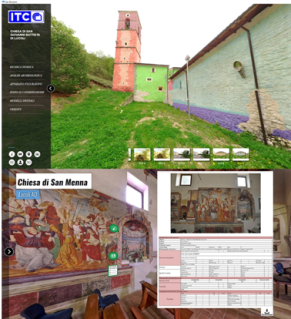La linea di ricerca definisce protocolli innovativi per la diagnostica non invasiva del patrimonio, a supporto della manutenzione del patrimonio costruito, anche attraverso l’avvio di buone pratiche. L’aspetto innovativo della ricerca mira a testare gli strumenti digitali idonei a favorire la conservazione e il restauro attraverso la generazione di modelli digitali semantici finalizzati alla manutenzione predittiva dei manufatti
1.Marra, A., & Fabbrocino, G. (2020). On the SeVAMH survey protocol for safety and safeguard of artistic assets. Overview and validation at the Monumental complex of Santa Chiara in Naples. Restauro Archeologico, 28(2), 4–17.
2.Marra, A., & Fabbrocino, G. (2020). Open-access web mapping as a virtual survey tool for cultural heritage: An application to the Armenian religious architecture documented by Paolo Cuneo. DISEGNARECON, 13(25), 7–1.
3.Marra, A., Fabbrocino, G., & Savorra, M. (2020). Un modello digitale per l’analisi e la tutela del patrimonio: la Certosa di Trisulti. In Architettura eremitica. Sistemi progettuali e paesaggi culturali. Atti del V Convegno Internazionale di Studi – Certosa del Galluzzo 2020 (pp. 34–39). Firenze: Edifir.
4.Marra, A., & Fabbrocino, G. (2020). Crowd-based tools for indirect condition assessment and conservation of cultural heritage. In Euro-Mediterranean Conference (pp. 38–50). Cham: Springer International Publishing.
5.Marra, A., Gerbino, S., & Fabbrocino, G. (2020). High performance laser survey and 3D stress analysis for maintenance and preservation of artistic assets. In Proceedings of the IMEKO International Conference on Metrology for Archaeology and Cultural Heritage, MetroArchaeo (pp. 214–219).
6.Marra, A., Gerbino, S., Greco, A., & Fabbrocino, G. (2021). Combining integrated informative system and historical digital twin for maintenance and preservation of artistic assets. Sensors, 21(17), 5956.
7.Trizio, I., Demetrescu, E., & Ferdani, D. (2021). Virtual reconstruction and restoration. Comparing methodologies, practices, and experiences. DISEGNARECON, 14(27).
8.Trizio, I., Savini, F., Ruggieri, A., & Fabbrocino, G. (2021). Digital environment for remote visual inspection and condition assessment of architectural heritage. In C. Rainieri, G. Fabbrocino, N. Caterino, F. Ceroni, & M. A. Notarangelo (Eds.), Civil Structural Health Monitoring. CSHM 2021. Lecture Notes in Civil Engineering, 156 (pp. 869–888). Cham: Springer.
9.Marra, A., Trizio, I., & Fabbrocino, G. (2021, March). Digital tools for the knowledge and safeguard of historical heritage. In International Workshop on Civil Structural Health Monitoring (pp. 645–662). Cham: Springer International Publishing.
10.Marra, A., Rainieri, C., & Fabbrocino, G. (2022). On the role of historical research in the structural condition assessment of heritage structures. In Handbook of Cultural Heritage Analysis (pp. 1701–1722). Cham: Springer International Publishing.
11.Marra, A., & Fabbrocino, G. (2022). Strutture ospedaliere da tutelare? L’insula dell’ospedale napoletano dei Pellegrini tra questioni di sicurezza e conservazione. In La città e la cura. Spazi, istituzioni, strategie, memoria / The City and Healthcare. Spaces, Institutions, Strategies, Memory (pp. 668–680). AISU International.
12.Fabbrocino, G., & Trizio, I. (2022). Metodologie digitali per la documentazione e conservazione del patrimonio storico-architettonico. In M. Sargolini, I. Pierantoni, V. Polci, & F. Stimilli (Eds.), Progetto Rinascita Centro Italia. Nuovi sentieri di sviluppo per l’Appennino Centrale interessato dal sisma del 2016 (pp. 69–72). Pescara: Carsa Edizioni.
13.Trizio, I., Savini, F., Marra, A., & Fabbrocino, G. (2022). Integrated survey procedures for seismic protection of monumental liturgical furniture. Journal of Physics: Conference Series, 2204, 012067. https://doi.org/10.1088/1742-6596/2204/1/012067
14.Marra, A., Fabbrocino, G., & Trizio, I. (2023). On the interoperability performance of HBIM models for structural conservation and upgrading of building aggregates in the Italian minor centres. VITRUVIO – International Journal of Architectural Technology and Sustainability, 8, 140–151.
15.Marra, A., Trizio, I., & Savini, F. (2023). Multidisciplinary approach for the knowledge of historical built: Digital tools for the virtual restoration. In Digital Restoration and Virtual Reconstructions: Case Studies and Compared Experiences for Cultural Heritage (pp. 205–224). Cham: Springer International Publishing.
16.Savini, F., Iezzi, S., Trizio, I., Fabbrocino, G., & Sandoli, A. (2024). Historical, architectural, and structural virtual tour for conservation and maintenance of architectural heritage. International Journal of Architectural Heritage, 1–19. https://doi.org/10.1080/15583058.2024.2344175
17.Trizio, I., Savini, F., Ciuca, G., Sandoli, A., Fabbrocino, G., & Marra, A. (2024). Progettazione integrata in ambiente HBIM del recupero di un’area urbana in stato di abbandono / Integrated design in the HBIM environment for the rehabilitation of a derelict urban area. In XIIth ReUSO Edition. Documentation, Restoration and Reuse of Heritage (Bergamo, 29–31 October 2024). Alghero: Publica.


